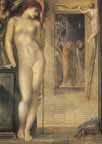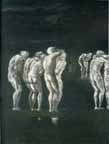 The theme and subject matter of Sir Edward Burne-Jones' Venus Epithamalia (1871) reflect the artist's passionate and tumultuous affair with Maria Zambaco, whom he saw as his own femme fatale. The appearance of the femme fatale in his work marked a distinct change, as the paintings from the preceding period (1858-1864) were naively simplistic in both style and treatment of women. His use of the subject Venus within Venus Epithamalia echoes an earlier Venus completed in 1861, which concerns itself "with the celebration of an uncomplicated and innocent beauty," a trend that repeated itself within this early body of work (Waters). In this earlier painting, one of Burne-Jones' first attempts in oil, Venus tilts her head slightly to her left while directing her longing gaze to an unseen person or object on the opposite side outside of the picture frame. The artist portrays only her face, framed by her long hair and a simple crown of what appears to be small flowers, her neck and her shoulders, in this tiny ode to beauty.
The theme and subject matter of Sir Edward Burne-Jones' Venus Epithamalia (1871) reflect the artist's passionate and tumultuous affair with Maria Zambaco, whom he saw as his own femme fatale. The appearance of the femme fatale in his work marked a distinct change, as the paintings from the preceding period (1858-1864) were naively simplistic in both style and treatment of women. His use of the subject Venus within Venus Epithamalia echoes an earlier Venus completed in 1861, which concerns itself "with the celebration of an uncomplicated and innocent beauty," a trend that repeated itself within this early body of work (Waters). In this earlier painting, one of Burne-Jones' first attempts in oil, Venus tilts her head slightly to her left while directing her longing gaze to an unseen person or object on the opposite side outside of the picture frame. The artist portrays only her face, framed by her long hair and a simple crown of what appears to be small flowers, her neck and her shoulders, in this tiny ode to beauty.
 Venus Epithamalia, on the other hand, "shows how far Burne-Jones' design had moved from the quaintness of his work ten years earlier" (Waters). His work from 1870-1875 -- a period of psychological distress resulting from what Waters decsibes as the "disastrous climax" of the Zambaco affair -- portrays a sense of pessimism and anguish characterized by angular figures, "their expressions often painful," with "nervous, gestural and erratic" movements dominating the canvas (Waters). Venus Epithamalia epitomizes this change in style and theme, as the sensuality of the nude Venus (the femme fatale) dominates the picture, the tension of her figure echoing that of the nude figures of the souls awaiting transport to Hades within Souls on the bank of the River Styx. Thus, as a result of the themes of punishment and distress within Souls, a comparison to Venus Epithamalia, as well as Burne-Jones' own personal romantic situation "is telling" (Waters). Above, to the figure's right, the blinded face of Cupid frames the action, as Burne-Jones's underlying pessimism pervades his portrayal of Venus as a victim of love and circumstance. (She has an unwanted marriage with Vulcan -- the word Epithamalia refers to marriage.) As opposed to the Venus of his earlier work, this one represents the antithesis of naive simplicity, since she loves Mars rather than Vulcan. Maria Zambaco, in fact, was married when she began her affair with Burne-Jones, thus suggesting the relationship between the real and the mythological, as well as the artist's transformation from unrefined dreamer to tragic lover.
Venus Epithamalia, on the other hand, "shows how far Burne-Jones' design had moved from the quaintness of his work ten years earlier" (Waters). His work from 1870-1875 -- a period of psychological distress resulting from what Waters decsibes as the "disastrous climax" of the Zambaco affair -- portrays a sense of pessimism and anguish characterized by angular figures, "their expressions often painful," with "nervous, gestural and erratic" movements dominating the canvas (Waters). Venus Epithamalia epitomizes this change in style and theme, as the sensuality of the nude Venus (the femme fatale) dominates the picture, the tension of her figure echoing that of the nude figures of the souls awaiting transport to Hades within Souls on the bank of the River Styx. Thus, as a result of the themes of punishment and distress within Souls, a comparison to Venus Epithamalia, as well as Burne-Jones' own personal romantic situation "is telling" (Waters). Above, to the figure's right, the blinded face of Cupid frames the action, as Burne-Jones's underlying pessimism pervades his portrayal of Venus as a victim of love and circumstance. (She has an unwanted marriage with Vulcan -- the word Epithamalia refers to marriage.) As opposed to the Venus of his earlier work, this one represents the antithesis of naive simplicity, since she loves Mars rather than Vulcan. Maria Zambaco, in fact, was married when she began her affair with Burne-Jones, thus suggesting the relationship between the real and the mythological, as well as the artist's transformation from unrefined dreamer to tragic lover.
Questions
1. Burne-Jones utilized various forms of architecture both to create depth and to portray dynamics of power within his subjects. For example, in Sidonia von Bork, the architectural forms stand behind the subject, whom Burne-Jones did not frame in by architecture as he had done in many of his other works like Danae or The Tower of Brass. Burne-Jones thus reveals her position of power and her keen ability to manipulate this position. In Danae, the architectural forms in the background not only tower over the figure, but create a frame around her, thus emphasizing her position of weakness and vulnerability. Burne-Jones also reveals her weakness through the stance of the figure, which is similar to that of Venus in Epithamalia. Comment on the architectural forms in Epithamalia. How does Burne-Jones illustrate the position and dynamic of the figure?
2. Elaborate on the comparison and connection between Venus Epithamalia and Souls on the Styx. What is the significance between the parts of the figure portrayed (i.e. the viewer cannot see the faces of the figures in Souls) and the thematic structure of these works? Does the fact that Venus is nude illustrate her vulnerability, or is it merely Burne-Jones indication of the humanly beauty that still exists in situations of tragic love?
3. After his trips to Italy in 1859 and 1862, Burne Jones' work became enriched by "rich and deep dark colouration, tending towards the choice of iron reds and dark oranges combined with deep greens" (Waters). Are these Italian influences present in Venus Epithamalia? In what way did he fuse classical and medieval characteristics within this work (both stylistically and thematically)?
Bibliography
Waters, Bill. Burne-Jones -- A Quest for Love. [Works by Sir Edward Burne-Jones Bt and Related Works by Contemporary Artists]. London: Peter Nahum, 1993.
Last modified 29 October 2004